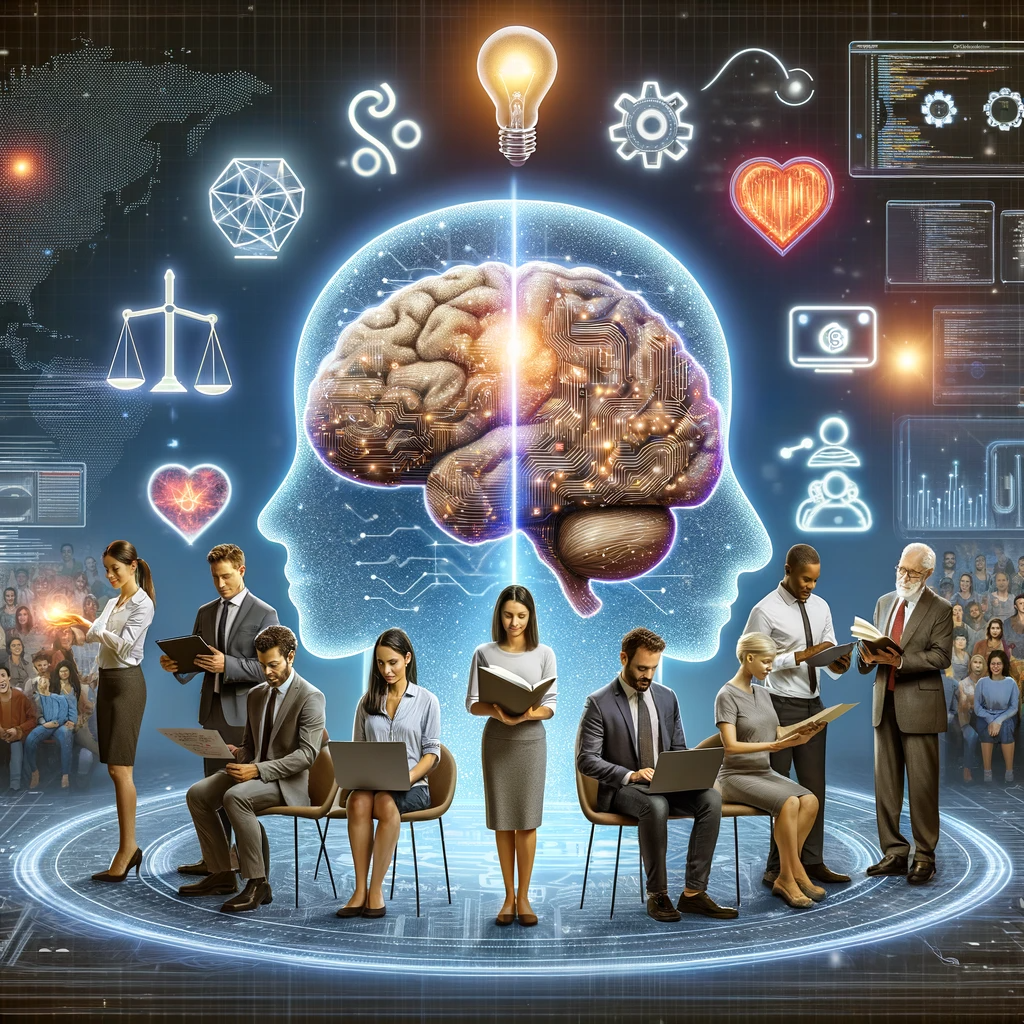Introduction
As Artificial Intelligence (AI) increasingly becomes a cornerstone of modern business practices, mastering change management in this domain is not just a necessity, it’s an imperative. This post integrates insights from Salesforce’s Trailhead on empowering workers in the AI Age with perspectives from Deloitte and Accenture, offering a comprehensive view on navigating the complexities of AI implementation and change management.

The Human Element in AI Adoption
Salesforce’s Trailhead underscores the importance of a human-centred strategy in AI adoption, emphasising the need to prioritise people and their understanding in the AI transformation journey. This approach aligns with Deloitte’s findings that organisations with data-driven cultures and high levels of trust and agility significantly exceed their business goals.
Addressing AI Implementation Challenges
Adopting AI isn’t without its challenges. According to Accenture, effective change management goes beyond just technological implementation; it requires a human-first approach that aligns the workforce with digital technologies and leadership support. Similarly, Salesforce Trailhead highlights the importance of creating a safe and supportive environment to encourage teams to embrace AI, foster transparency, and promote innovation.
Combating Fears of AI and Job Loss
One of the major concerns in AI implementation is the fear of AI taking jobs. Deloitte’s research indicates that high-achieving organisations report more fear, yet also show little desire to reduce employee headcount, focusing instead on training and change management. Salesforce Trailhead suggests communicating the benefits of AI clearly to workers, emphasising how AI can enhance productivity and automate tedious tasks.
The Role of Change Management in AI Integration
Effective change management is key to successful AI integration. Deloitte points out the need for change management experts to help integrate AI into organisational processes. Salesforce Trailhead also advocates for building trust through effective communication and upskilling opportunities.
Redefining Work with AI Automation
Automation through AI does not necessarily mean job elimination. Deloitte highlights that many companies view AI as a tool to free up workers for more creative tasks, redefining work rather than reducing workforce. Salesforce Trailhead supports this view, suggesting an outcome-focused mindset that goes beyond viewing AI as just a tool, fostering user connections and collaborative progress.
Conclusion
The integration of AI into our business practices is not just a technological journey; it’s a deeply human one. By addressing specific human concerns surrounding AI integration – such as job displacement fears, ethical implications, and the need for upskilling – and implementing effective change management strategies, organisations can ensure a transition that not only empowers their workforce but also unleashes the full potential of AI.
A successful transition isn’t just about the seamless adoption of technology; it’s measured by tangible outcomes.
- Employee Productivity through AI-Enabled Automation: In various industries, AI-enabled automation has significantly enhanced employee productivity. For instance, in manufacturing, AI-driven predictive maintenance systems help in reducing equipment downtime and increasing production efficiency. A study by McKinsey & Company highlighted the potential of AI and automation in transforming various occupations and sectors. In particular, tasks that involve routine or predictable activities, such as operating machinery or data processing, are increasingly being automated, leading to improvements in operational efficiency and productivity. This transformation allows employees to focus on more complex and creative tasks, thereby increasing overall productivity.
- Employee Happiness and Engagement through AI-Powered HR Tools: AI technologies are being increasingly used in Human Resources (HR) to improve employee happiness and engagement. For example, AI-powered chatbots and virtual assistants can provide quick and personalised responses to employee queries, enhancing the overall employee experience. AI tools can also be used for talent acquisition, training, and personal development, making the HR processes more efficient and employee-centric.
- Innovation through AI-Driven Analytics and Research: AI has a profound impact on innovation across various sectors. For instance, in the pharmaceutical industry, AI algorithms are being used to analyse vast amounts of data for drug discovery and development. This not only speeds up the research process but also allows for more innovative approaches to developing treatments for complex diseases. Similarly, in the field of finance, AI-driven analytics are used for market analysis and predicting consumer trends, leading to more innovative financial products and services. The McKinsey report “Jobs Lost, Jobs Gained: Workforce Transitions in a Time of Automation” emphasises the benefits of AI and automation to users and businesses, and the economic growth that could come via their productivity contributions, which includes fostering innovation.
These examples demonstrate the diverse ways in which AI is contributing to improvements in productivity, happiness, engagement, and innovation in the workplace.
So, how can you navigate this exciting journey?
- Transparency and communication: Keep your employees informed about AI plans, address their concerns openly, and involve them in the process.
- Focus on upskilling: Help your workforce develop the skills needed to work alongside AI, not compete with it. Offer training programs and create opportunities for reskilling and upskilling.
- Human-centred design: Ensure AI solutions are designed with human needs and values in mind. Focus on ethics, fairness, and explainability to build trust and acceptance.
I encourage you to share your insights and experiences. How have you managed the human side of AI integration in your organisation? What challenges have you faced, and what successes have you celebrated? Share your stories in the comments below or join our community discussion. Let’s learn from each other and empower our workforce to thrive in the age of AI.
By taking these steps, you can transform AI integration from a daunting challenge into a catalyst for progress, unlocking a future where humans and machines work together to achieve remarkable results.